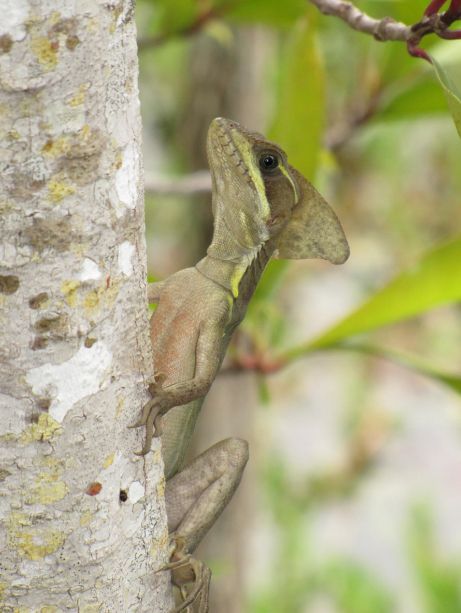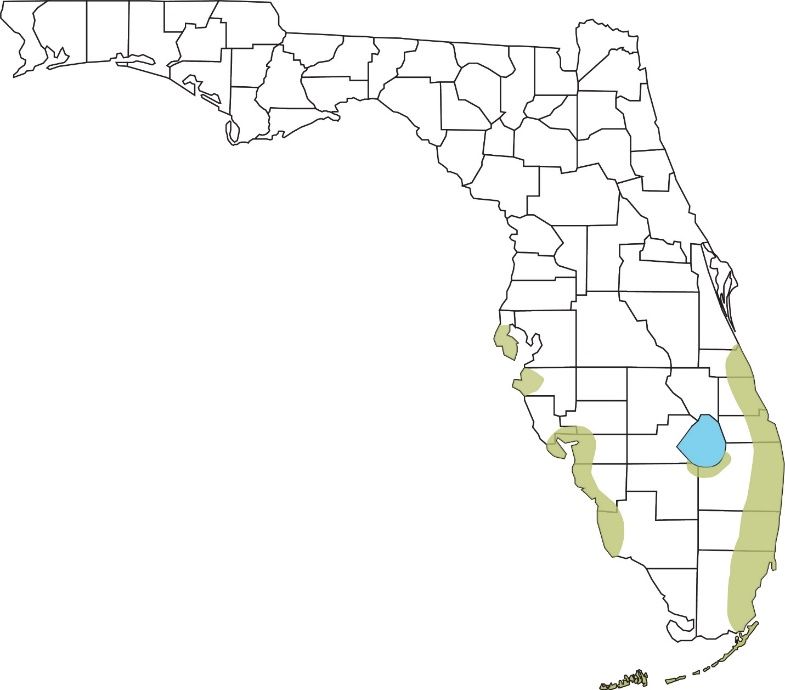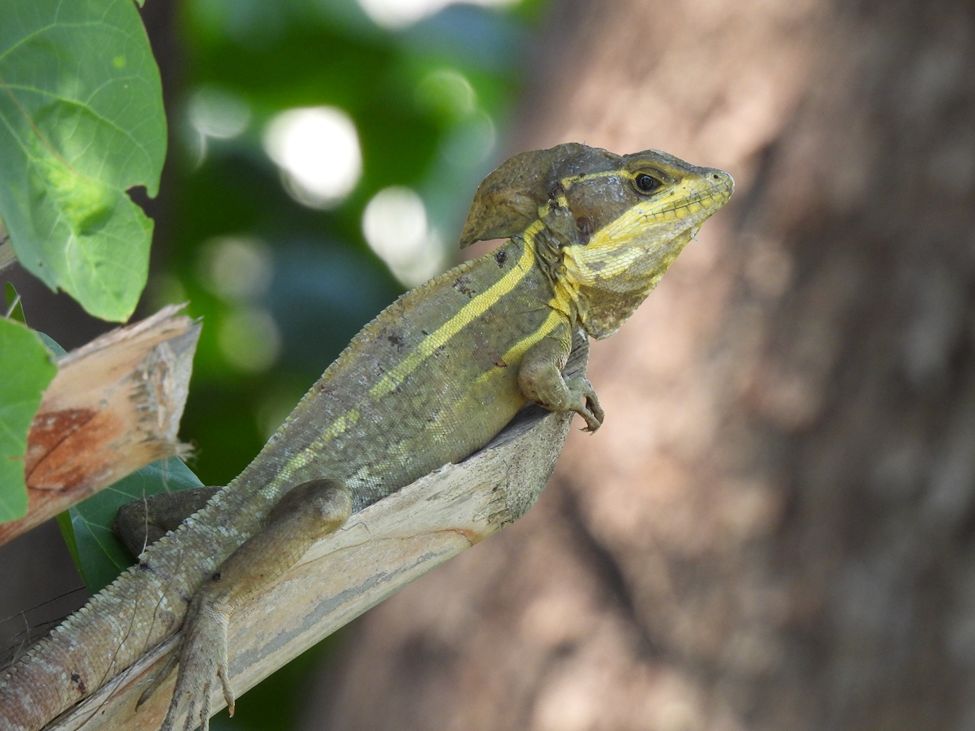Introduction
This publication presents information about the nonnative lizard Basiliscus vittatus (brown basilisk) in Florida. It contains information about brown basilisk identification, natural history, and distribution in Florida. The intended audience includes homeowners and land managers primarily in central and south Florida.
General Background
While not all introduced nonnative species can survive and produce self-sustaining populations without human assistance, some do. They are referred to as “established” in new areas (Iannone et al. 2021). Florida has experienced more introductions of nonnative reptile species than any other region on Earth, and there are approximately three times as many species of established, nonnative lizards in the state as there are native species (Krysko et al. 2016). These established species range in size from the small (to 6 in.) Cuban brown anole (Anolis sagrei), to the large (to 7 ft.) Nile monitor (Varanus niloticus). Among Florida’s approximately 50 species of nonnative lizards is the brown basilisk (Basiliscus vittatus), an established species within the family Corytophanidae (Krysko et al. 2006). Members of the family Corytophanidae are referred to as helmeted or casque-headed lizards due to their distinct head crests (Figure 1).

Credit: Steve Johnson, UF/IFAS Wildlife Ecology and Conservation
Distribution in Florida
The Florida Fish and Wildlife Conservation Commission (FWC) reports that brown basilisks were introduced to Florida through the pet trade and were first observed in the wild in 1963. They are considered an established nonnative species. In February 2022, the Florida Museum of Natural History Herpetology Collection database contained 160 vouchered specimens of brown basilisks in Florida. Vouchered specimens are those that are authenticated with evidence. Most of these specimens were collected in coastal southeast Florida from Brevard County south to Monroe County. There were additional specimens vouchered in Manatee, Lee, and Collier Counties in southwest Florida. Brown basilisks were also vouchered in Hendry County and western Palm Beach County. Numerous additional observations of brown basilisks are reported in iNaturalist and EddMaps, which are online tools citizen scientists can use to document observations of non-native species. Based on these records, brown basilisks appear to be established along much of Florida’s southern coastal areas. They are seen regularly on the east coast from southern Brevard County through the Florida Keys. On the west coast, they are known from Pinellas County south to Naples in Collier County. Brown basilisks are also established along the southern shore of Lake Okeechobee (Figure 2). Isolated reports in other areas of central Florida could indicate populations in the early stages of establishment.

Credit: UF/IFAS
Identifying Brown Basilisks
Brown basilisks, as their name implies, are mainly brown or dark olive in color. They almost always have a distinct yellow or cream-colored stripe on each side of their body that runs from the eye down their back (Figure 3). A second stripe is often visible on the face extending to the shoulder. They have long, thin tails and particularly long rear toes. The most distinct feature that differentiates them from all other Florida lizards is their prominent head crest. The crest is largest in adult males, and they sometimes have a distinct, fin-like crest on their back and tail. Small basilisks of both sexes lack the head crest. The rear legs of juveniles are especially long. Juvenile and female brown basilisks have dark bars on their back and sides (Figure 4).
The body of adult brown basilisks ranges from approximately 4.5 to 6.5 inches long and males are larger than females. When including their long tail, adults range in size from 11 to 27 inches (Fitch 1973a and b; Savage 2000; Krysko et al. 2019).

Credit: Steve Johnson, UF/IFAS Wildlife Ecology and Conservation

Credit: Steve Johnson, UF/IFAS Wildlife Ecology and Conservation
Brown Basilisk Natural History
Brown basilisk lizards are native to lowland habitats in coastal regions of central México south through Panama in Central America (Hirth 1963; Reptile Database 2022). They occur in both disturbed and undisturbed areas in their native habitat. In Florida, they are most common near water in areas disturbed by people, including canals, shorelines of lakes, retention ponds, and ditches. They prefer areas with thick vegetation such as Brazilian peppertree, Australian pine, mangroves, willow, etc., but frequently bask and search for insects on sidewalks, roads and in parking lots (Krysko et al. 2006).
Brown basilisks are wary, and, if approached, they quickly flee into vegetation. They are strong swimmers, and, if near water when disturbed, they quickly dive under the surface or even run across the water. The ability to “run on water” is a notable and unusual behavior of this crested lizard. They use rapid movements of their rear legs and feet to “slap” and “stroke” the water. The initial “slap” creates an upward force as the foot is plunged vertically into the water. During the “stroke” the lizard is propelled forward as the foot is quickly swept back in the water (Hsieh and Lauder 2004). Small individuals can generate considerably more upward force than large ones (Glasheen and McMahon 1996). As a result, juvenile basilisks run across the water’s surface more often than adults, which usually dive into the water (Rand and Marx 1967). This behavior of juvenile brown basilisks is the reason the species is known as the crested lizard that runs on water.
UF/IFAS Extension agent Ken Gioeli (lead author on this publication) described his first experience seeing brown basilisks in St. Lucie County, Florida. He recalled “quick splashes of water followed by rustling in the nearby saw palmettos” and said that the lizards were “somewhat akin to what you might see in a Jurassic Park movie and reminiscent of mini-velociraptors.”
Brown basilisks are diurnal and are active year-round in Florida, especially on warm, sunny days. At night they sleep on limbs and branches well above the ground (Krysko et al. 2006). Like many lizards, brown basilisks feed on insects such as grasshoppers, butterfly caterpillars and flies (Hirth 1963). However, they will also prey upon spiders, crabs, and even brown anole lizards and small snakes. They are known to eat fruits of Ficus plants (Krysko et al. 2006).
Impacts of Brown Basilisk in Florida
An invasive species is defined as a plant, animal, or microbe that is found outside of its native range, where it negatively impacts the ecology, economy, or quality of human life in the area where it was introduced by people. Presently, brown basilisksdo not fit this definition, but they have not been studied in enough detail to rule out their potential for being considered invasive.
Ecological Impacts
Although the ecology of brown basilisks in Florida is poorly known, it seems unlikely that they are negatively impacting native species by predation or competition. However, research on the topic is needed to state this with certainty. Several species of native Florida snakes are known to eat small basilisks (Meshaka et al. 2004), and some native birds (e.g., herons) likely feed on this introduced lizard.
Human Quality-of-Life Impacts
Brown basilisks do not pose a direct threat to pets or people. The bite of a large brown basilisk is potentially painful, but unless the lizard is being handled there is no chance of a bite. In fact, these lizards are exceptionally fast moving and readily avoid people.
Several species of introduced lizards have been identified as the source of blood meals for the mosquito Culex nigripalpus in Florida. Although the invasive brown anole was the most fed-upon of these, the brown basilisk was among four other diurnal, arboreal lizards identified in the study (Reeves and Burkett-Cadena 2022). Culex nigripalpus is a known vector for West Nile virus and St. Louis encephalitis virus, both of which infect mammals, including humans. Thus, introduced lizards such as the brown basilisk may pose an indirect threat to humans by facilitating spillover of viruses to humans via mosquito vectors.
Economic Impacts
There are currently no known negative impacts of brown basilisks on Florida’s economy.
What You Can Do
University of Florida researchers and state agencies are trying to gain greater insight on nonnative reptiles and their distribution and impacts in Florida. It is important for people to report sightings of brown basilisks and other nonnative reptiles and amphibians. It is particularly important to report them in areas where they have not been documented previously (see Figure 2 range map). You can engage in citizen science by reporting brown basilisks using the EDDMapS online mapping tool. Visit the EDDMapS website to report a sighting of brown basilisks or other nonnative animals in Florida.
Becoming better educated about nonnative and invasive species is something all Floridians can do to help our native plants and animals. It is unethical and against state law to release nonnative animals in Florida. Never release an unwanted exotic pet! The state of Florida operates an Exotic Pet Amnesty Program that helps people find homes for unwanted pet reptiles and other exotic animals. To learn more, visit the Florida Fish and Wildlife Conservation Commission’s Pet Amnesty website.
Learning more about Florida’s unique plants, animals, and ecosystems and then sharing that knowledge with others is a great way to become more environmentally literate and be an advocate for our native species. One way to do this is to get trained as a Florida Master Naturalist. See the link below to learn more about this award-winning adult environmental education program developed by the University of Florida.
You can also join one of Florida’s Cooperative Invasive Species Management Areas (CISMAs). CISMAs are a partnership of local, state, and federal government agencies, non-profit organizations, tribes, and individuals working together to address invasive species management. Local CISMAs offer hands-on opportunities to learn and assist with resource management. These groups are facilitated through the Florida Invasive Species Partnership (FISP). To learn more and find other educational resources on invasive species, visit the FISP website.
Get involved with The Nature Conservancy (TNC) in Florida. TNC launched its Center for Conservation Initiatives (CCI), a center of excellence for conservation, to help address the state’s environmental issues by providing opportunities for educating and empowering future conservationists, cultivating scientific discovery and research, and engaging with local communities and individuals to advance conservation and nature resource stewardship. Working closely with local CISMAs, CCI offers a variety of training opportunities on conservation issues—nonnative and invasive species, prescribed fire, and much more to citizens and organizations within Florida and beyond. To learn more, visit the Center for Conservation Initiatives webpage.
Additional Sources of Information
EDDMaps: https://www.eddmaps.org/
FWC Pet Amnesty Program: https://myfwc.com/wildlifehabitats/nonnatives/amnesty-program/
Florida Master Naturalist Program: https://masternaturalist.ifas.ufl.edu/
Florida Invasive Species Partnership: https://www.floridainvasives.org/
Center for Conservation Initiatives: https://www.nature.org/cci
Literature Cited
Fitch, H. S. 1973a. “A Field Study of Costa Rican Lizards.” University of Kansas Science Bulletin 50:39–126. https://doi.org/10.5962/bhl.part.25758
Fitch, H. S. 1973b. “Population Structure and Survivorship in Some Costa Rican Lizards.” Occasional Papers of the University of Kansas Museum of Natural History 18:1–41. https://doi.org/10.5962/bhl.part.17265
Glasheen, J. W., and T. A. McMahon. 1996. Size-Dependence of Water-Running in Basilisk Lizards (Basiliscus basiliscus). The Journal of Experimental Biology 199:2611–2618. https://doi.org/10.1242/jeb.199.12.2611
Hirth, H. F. 1963. “The Ecology of Two Lizards on a Tropical Beach.” Ecological Monographs 33:83–112. CISMA. https://doi.org/10.2307/1948557
Hsieh, S. T., and G. V. Lauder. 2004. “Running on Water: Three-Dimensional Force Generation by Basilisk Lizards. Proceedings of the National Academy of National Academy of Sciences 101:16784–16788. https://doi.org/10.1073/pnas.0405736101
Iannone, B. V., E. C. Bell, S. Carnevale, J. E. Hill, J. McConnell, M. Main, S. Enloe, S. Johnson, J. Cuda, S. Baker, and M. Andrew. 2021. “Standardized Invasive Species Terminology for Effective Education of Floridians.” FOR730/FR439, 8/2021”. EDIS 2021 (4):8. https://doi.org/10.32473/edis-fr439-2021
Basiliscus vittatusIguana
Krysko, K. L., L. A. Somma, D. C. Smith, C. R. Gillette, D. Cueva, J. A. Wasilewski, K. M. Enge, S. A. Johnson, T. S. Campbell, J. R. Edwards, M. R. Rochford, R. Tompkins, J. L. Fobbs, S. Mullins, C. J. Lechowicz, D. Hazelton, and A. Warren. 2016. “New Verified Nonindigenous Amphibians and Reptiles in Florida through 2015, with a Summary of Over 152 Years of Introductions.” IRCF Reptiles and Amphibians 23: 110–143. https://doi.org/10.17161/randa.v23i2.14119
Krysko, K. L., K. M. Enge, and P. E. Moler. 2019. Amphibians and Reptiles of Florida. Gainesville: University of Florida Press. 706 pp.
Meshaka, W .E., B. P. Butterfield, and B. J. Hauge. 2004. The Exotic Amphibians and Reptiles of Florida. Krieger Publishing Company, Malabar, FL. 155 pp.
Rand, A. S., and H. Marx. 1977. Running Speed of the Lizard Basiliscus basiliscus on Water.” Copeia 1967:230–233. https://doi.org/10.2307/1442206
Savage, J. M. 2002. The Amphibians and Reptiles of Costa Rica: A Herpetofauna between Two Continents, Between Two Seas. Univ. Chicago Press, Chicago.